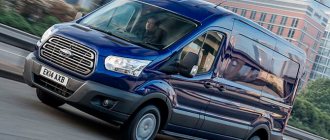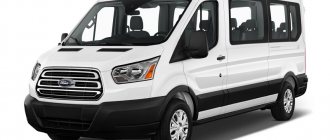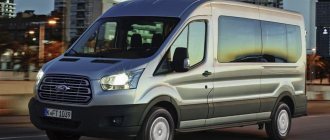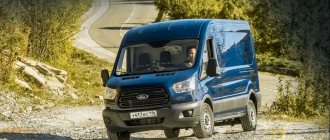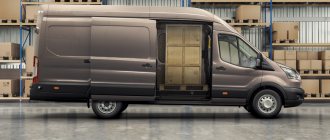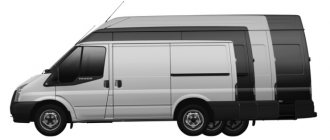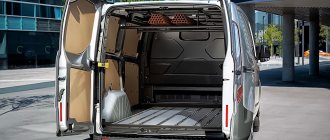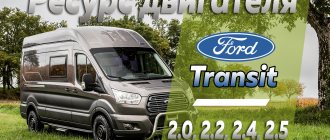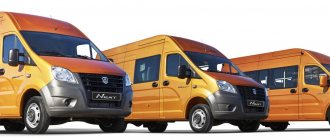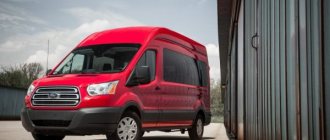Ford Transit fuel tank sizes
The width of Ford Transit fuel tanks for all modifications is 80 (l).
Fuel tank parameters for standard modifications:
2.2 l., Diesel, Mechanical, 6 speed, Rear:
2.2 l., Diesel, Mechanical, 6 tbsp., Full:
2.2 l., Diesel, Mechanical, 6 speed, Front:
Tank characteristics:
The main characteristics of the fuel tank include the following indicators:
- Length (L): overall length at the most protruding parts;
- Width (B): overall width at the most protruding parts;
- Height (H): overall height at the most protruding parts;
- Volume.
Important: detailed parameters of automobile fuel tanks by modification are presented in the table below.
is currently being produced.
Other parameters of Ford Transit:
| General parameters of Ford Transit fuel tanks | |||
| Drawing General General view of fuel tanks | Width min (mm) Minimum fuel tank width for different Ford Transit modifications. | ||
The measurement is taken on the outside.
| Width max (mm) Maximum width of the fuel tank for different modifications of Ford Transit. The measurement is taken on the outside. | Modifications Number of modifications of the model in our database | ||
| (drawing) | 80 (l) | 80 (l) | 9 |
| Ford Transit fuel tank parameters | |
| Year Year of manufacture of the model or modification of the car | |
Caution: the above data are the official figures of the manufacturer, however, please note that the information is for reference only and does not guarantee absolute accuracy.
Source: razmery.info
Ford Transit - technical specifications
Navigation
- Those. characteristicsGenerationsNewsVideoCompetitorsGo back
The American company Ford spent years designing the Ford Transit van and making sure that it would fully meet customer requirements.
The car is a far improvement over its predecessor, the Ford Econoline, in terms of fitness for purpose, modern safety standards and efficiency.
For the Russian market, the van is available with a 2.2-liter Duratorq diesel power unit with a capacity of 125 to 155 hp. With. and a torque of 350 Nm. The engine is paired with a manual transmission. The van is available with front, rear and all-wheel drive.
Ford Transit is available in two versions: a cargo van and a passenger van, which in turn have different lengths and heights.
| Volume (l) Tank volume in (l) | ||||
| 2.2 l., Diesel, Mechanical, 6 speed, rear | ||||
| Fuel tank volume | 80 (l) | |||
| 2.2 l., Diesel, Mechanical, 6 tbsp., Full | ||||
| Fuel tank volume | 80 (l) | |||
| 2.2 l., Diesel, Mechanical, 6 speed, Front | ||||
| Fuel tank volume | 80 (l) | |||
| 2.4 l., Diesel, Mechanical, 6 tbsp., Full | ||||
| Fuel tank volume | 80 (l) | |||
| 2.4 l., Diesel, Mechanical, 6 speed, rear | ||||
| Fuel tank volume | 80 (l) | |||
| 2.2 l., Diesel, Mechanical, 5 speed, Front | ||||
| Fuel tank volume | 80 (l) | |||
| 2.2 l., Diesel, Mechanical, 6 speed, rear | ||||
| Fuel tank volume | 80 (l) | |||
| 2.2 l., Diesel, Mechanical, 6 tbsp., Full | ||||
| Fuel tank volume | 80 (l) | |||
| 2.2 l., Diesel, Mechanical, 6 speed, Front | ||||
| Fuel tank volume | 80 (l) | |||
| Length x Width x Height (mm): | L2 H2 | L3 H3 | L4 H3 |
| total length | 5531 | 5981 | 6704 |
| Overall width without mirrors / with mirrors | 2059 / 2474 | 2059 / 2474 | 2126 / 2474 |
| Overall height | 2490 – 2550 | 2720 – 2786 | 2720 – 2786 |
| Wheelbase | 3300 | 3750 | 3750 |
| Full mass | 3100/3500 | 3100/3500 | 3500/4600 |
| Side door opening width | 1300 | 1300 | 1300 |
| Cargo volume (FWD/RWD) | 10.0 / 9.5 | 13.0 / 12.4 | 15.1 |
| Capacity, Euro pallet | 4 | 4 | 5 |
Depending on the modification, the cargo space of a Ford Transit van may vary.
L×H×W cargo compartment, mm – 3044×1886×1784
Side door opening width – 1300 mm
Rear door opening width – 1565 mm
- Vertical walls of the cargo compartment increase useful volume
- Metal partition with viewing window
- Load securing loops are raised above floor level for easy load securing
- Washable, all-over protective floor covering makes it easy to keep your van clean
- The widest side door in the segment makes loading easy, even with a forklift.
L×H×W cargo compartment, – 3494×2125×1784
Side door opening width – 1300
Rear door opening width – 1565
- Vertical walls of the cargo compartment increase useful volume
- Length and volume increased
- Metal partition with viewing window
- Load securing loops raised above floor level
- Washable continuous protective floor covering.
L×H×W cargo compartment – 4217×2125×1784
Side door opening width – 1300
Rear door opening width – 1565
- Vertical walls of the cargo compartment increase useful volume
- Length and volume increased
- Metal partition with viewing window
- Load securing loops raised above floor level
- Load securing loops raised above floor level
Ford Transit is equipped with modern safety systems and has passed all crash tests perfectly.
Standard equipment includes ABS, RSC (which will prevent the car from rolling over) and a tire pressure monitoring system.
The Hill Start function is also installed, which will prevent the car from rolling when driving on slopes.
There are front and side airbags for the driver and front passenger. There is a Safety Canopy system that includes side inflatable curtains.
The salon is quite practical and comfortable. The seats are upholstered in good quality material. The driver's seat has 8 different adjustment options and is also heated. There is an armrest height adjustment and electrically adjustable and heated mirrors.
The dashboard is multifunctional. It has a built-in modern multimedia system with a touch screen and a CD player.
At the bottom of the dashboard there are two USB inputs, two sockets and an SD card reader.
There are cup holders and plenty of storage space for various small items.
Passenger models are equipped with huge windows that provide better visibility.
Source: vanlife.ru
Specifications Ford Tourneo Connect 1.6 TDCi 5door. (since 2014)
Specifications
Engine
Drive unit
Transmission
Suspension
Brakes
Dimensions
Other
Photo gallery Ford Tourneo Connect 1.6 TDCi
Ford in St. Petersburg
- Ford showrooms in St. Petersburg
- Ford auto parts in St. Petersburg
- Ford car services in St. Petersburg
- Ford auto wrecking yard in St. Petersburg
Ford News
Production of the F-Max truck tractor has started in Kaliningrad. The truck is equipped with a 12.7-liter turbo diesel engine with a capacity of 500 hp. and a 12-speed ZF automatic transmission.
Leaving the Russian passenger car market, Ford announces an unprecedented price reduction for its model line. The maximum discount on a Ford Focus can be 329,000 rubles.
Automotive giant Ford is preparing for global structural changes. The immediate plans include the reduction of thousands of jobs in European divisions and a revision of the model line, which, according to unconfirmed information, will expand to include the SUV segment and vans
Ford presented the Focus in hatchback and station wagon body styles with increased ground clearance, redesigned suspension, plastic trim on the sills and wheel arches
Ford has begun production of all-electric Ford Transit WORK XL minibuses with a load capacity of up to 1275 kg. for the carrier company DHL
The update occurred in security systems and lighting systems. In particular, parking sensors now have an increased coverage area, which makes it possible to integrate the system.
The updated SUV has improved sound insulation, updated bumpers, and changed the chrome radiator grille. In the cabin.
Review of Ford Transit 2006-2013
The production of the legendary Ford Transit commercial vehicle has been established since 1953, and with the release of each new model, the car gained the greatest popularity. More than six million copies were produced, most of which are still traveling to various corners of the vast planet. This is the most popular commercial vehicle up to 3.5 tons, with which only the domestic GAZelle can easily compete in Russia.
In the second half of 2006, the seventh generation was shown to the general public, which was consistently produced until 2013. Seventh generation transits are still in service with large logistics firms, banks and small and medium-sized businesses.
Content:
Price of new and used Ford Transit
On the Russian market, Ford Transit is presented exclusively in versions with a 2.2-liter Duratorq unit with a capacity of 125 or 136 hp. At the request of the client, the car can be equipped with front-wheel drive, rear-wheel drive or all-wheel drive.
In the “minimum” version, the car has an average wheelbase and a relatively small set of equipment. The price tag for this version starts from 1.906 million rubles. Additional discounts are available through the recycling program. Versions with a long wheelbase will cost more - from 1.906 to 2.336 million rubles. Modifications with an extended wheelbase (Jumbo) are considered the most top-end. Here price tags start at 2.151 million rubles.
The market for used Ford Transit models in Russia is one of the largest. The cost of a used car varies widely and depends on the condition, year of manufacture, configuration and equipment. Thus, models from 2004-2005 on the go can be purchased for 230,000-340,000 rubles. Newer cars (2007-2009) will cost 400,000-650,000 rubles. Cars from 2011-2013 will cost from 500,000 to 900,000 rubles.
Design and modifications
The car won the title of best international van in 2007. In honor of this event, the company showed the public an unusual modification of the Transit XXL stretch van. The car was sold only in North American markets. It had a standard design, adjusted for its unusual length and the presence of three doors on each side, two of them were sliding. It had more luxurious finishes inside.
A wide variety of modifications are available for buyers of an American van. Models are available for sale with three types of wheelbase lengths: standard, medium, extended. The roof height also varies depending on the modification.
Vans, depending on the type of cargo structure and size, have different tonnage, and shuttle buses can be tourist buses with 15-17 seats and city buses (up to 25 seats).
The standard modification has the following dimensions:
- length – 4863 mm;
- width – 1974 mm;
- height – 2084 mm;
- curb weight – 1800 kg;
- total weight – 3.5 tons;
- load capacity – 1420 kg;
- The cargo compartment volume is 5,200 liters.
The extended modification of the Ford Transit 2006-2013 with a high roof has the following meanings:
- length – 6403 mm;
- width – 1974 mm;
- height – 2623 mm;
- curb weight – 2140 kg;
- load capacity – 1350 kg;
- The cargo compartment volume is 14,300 liters.
In general, the car received a balanced appearance without frills, everything is neat and tasteful. In the front part there is a huge rectangular lighting system with an elongated upper-side corner. The optics has a two-story architecture. The first floor is designed as a square, and the second is spherical in shape.
The seventh generation received a longer version of the hood to give it a modern look. Due to this, the false radiator grille, which is a continuation of the massive front bumper, has been reduced. It consists of two horizontal plates, behind which a thin square grille is hidden. In the very center of Transit is the logo of the American automaker. The entire lower part of the front bumper is a series of air intakes, and in the corners there are niches for fog lights. The extreme parts of the front bumper are represented by turn signal indicators.
The profile features wide wheel arches, some stampings and turn signals. The passenger version has wide footrests. All modifications are equipped with the same side rear view mirrors. The glazing does not take up a large area, and the side doors sliding back with an electric drive can be made either of metal or entirely of glass. Combination options are more common. On one-tonne vehicles, two wheels are installed on the rear axle, on other versions there are 4 wheels.
The rear design of the Ford Transit 2006-2013 is even simpler. Two doors opening on opposite sides, a small bumper made of unpainted plastic and vertically oriented lights in the rear-side pillars. On the left side of the door is where the license plate is attached, and on the right is the door opening handle. Regardless of the height of the roof, one small fog lamp is located strictly above the opening of the luggage compartment at the rear.
Model history and purpose
Ford Transit is one of the oldest cars in the world. The first vehicle of this family appeared back in 1953 and was called FK 1000. In 1961, the van was renamed Ford Taunus Transit. There was no talk of export at that time. However, the production of cars gradually expanded, and the model itself experienced noticeable changes. The debut car called Ford Transit was presented in 1965. The van was produced in England, Belgium, Turkey, and then in China. The model was noticeably different from standard commercial vehicles in Europe. The wide track compared to its competitors gave many advantages, so the Ford Transit soon became very popular. In 1978, the premiere of the second generation of the model took place, which at that time was used not only in the commercial segment, but also in special services (Ambulance, Ministry of Emergency Situations, police).
4th generation
In 1986, production of the fourth generation of the model began. The car featured a “single-box” body design. The developers decided to abandon the strongly protruding hood (the windshield and hood were now located at the same angle). In 1992, the Ford Transit underwent a major restyling. The underbody has been completely redesigned and the distance between the axles has been increased. Changes also affected the design of bridges, where cylindrical bearings began to be used. The third Ford Transit was distinguished by its high maneuverability and speed, which attracted the interest of many customers. Single copies of this generation are still successfully used on the Russian market.
5th generation
In 1994, the Ford Transit underwent a restyling procedure, receiving a new dashboard and front end (the radiator grille made of horizontal bars was replaced by an oval cladding). A 2-liter engine from the Ford Scorpio has appeared in the line of power units. The third generation was sold in Europe until 2000.
6th generation
The sixth Ford Transit received a completely new appearance, borrowing features of the company's corporate identity used in the Focus model. The new modification was offered with front- and rear-wheel drive (V185 and V184). Versions with the Puma diesel engine installed in the Jaguar X-Type and Ford Mondeo were also available. An automatic transmission was offered for top-end variations. At the same time, the manufacturer took care of the driver, providing the seats and steering wheel with many adjustments, allowing you to choose the optimal position. Due to the high landing, good visibility was achieved. The interior of the Ford Transit IV became larger and was designed for 8 or 12 passengers. Based on the standard version, the automaker has also prepared a smaller version – Transit Connect. The model was made slightly smaller than the “progenitor”, adding to this a modified appearance. The maximum load capacity of the model is 900 kg.
Salon
The interior of the cabin looks completely utilitarian, hard plastics are used here, there are huge gaps and extraneous sounds everywhere, but the level of comfort for front passengers and the driver is acceptable, and considering that this is a commercial vehicle, it is absolutely luxurious. The Ford Transit has three seats in front, there is no central tunnel, but there is a parking brake handle between the driver's seat and the passenger sofa.
Scattered throughout the panels are small and large niches that are necessary in this car, and there is also a large number of cup holders of different sizes.
In front of the driver is a 4-spoke steering wheel with a central part in the form of an inverted trapezoid. Behind the wheel is a simple and informative dashboard with large tachometer and speedometer scales, and between the scales there is a non-color display of the on-board computer. The center console is large; in its lower part there is a place for the gearshift knob, and in the central part for two air intakes, between which there is a control unit for an audio system with two speakers. Below is the air conditioning control unit.
The seats have a sufficient range of adjustments, good padding, but poor lateral support.
Technical characteristics of Ford Transit 7
The car was sold with two 4-cylinder diesel power units, the volume of which was 2.2 and 2.4 liters. All engines were equipped with turbocharging, the cylinder arrangement was in-line.
- Engines with a volume of 2.4 liters were mainly sold with a power rating of 140 horsepower and a torque of 375 Nm. But there were also 115 hp. and 310 Nm of torque. The consumption of “heavy” fuel in the combined cycle was around 9-10 liters per 100 km.
- Engines with a volume of 2.2 liters received a greater variety of boosts. Their power line started at 85 hp. and continued up to 155 hp. Torque was 210 and 385 Nm, respectively, and fuel consumption in the combined cycle was 8-9 liters.
- There was also a limited version of the 7th Transit with a turbocharged 5-cylinder engine and an in-line arrangement. The engine was also diesel, its displacement was 3.2 liters, which allowed it to develop up to 200 horsepower and 470 Nm of torque. Fuel consumption was 10-11 liters.
The maximum speed declared by the manufacturer was 147 km/h. All engines met the Euro-4 environmental standard, and after that the 5-cylinder one met Euro-5.
Regardless of the internal combustion engine, only a 6-speed manual transmission was equipped, which can transmit all the power to both the front or rear axle, and to both at the same time.
The suspension of the Ford Transit 2006-2013 has not undergone any changes with the advent of the new generation. The front has the same independent design with MacPherson struts, and the rear has leaf spring architecture with anti-roll bar. The brakes are all-disc, and the front ones are ventilated. It is also equipped with an ABS system. The steering is equipped with power steering.
Engine
Ford Transit has a wide range of power units (petrol and diesel). The key feature of the engines available for the car is their efficiency. Advanced technologies have made it possible to significantly increase the efficiency of fuel consumption and reduce emissions of harmful substances.
For the passenger version, the top-end is the modern 5-cylinder diesel 3.2-liter Duratorq TDCi unit. This is the latest engine in the line of this series. Its torque is 470 Nm, power is 200 hp. Such characteristics allow it to be one of the most powerful in its segment.
The most common in the family is considered to be the line of 2.2-liter Duratorq diesel units (this is what is offered to Russians). These motors are designed to meet the strict environmental safety requirements of Euro-4. The power of the units varies from 100 to 155 hp. They have an environmental protection and fuel saving system ECO Pack, including:
- speed limiter. Set to 100 km/h. If desired, it can be disabled so as not to degrade the technical characteristics.
- Auto-Start-Stop function (turns off the engine under certain conditions and instantly starts the engine if necessary).
Other systems found in the latest generation Ford Transit engines include an advanced battery charge management function, an energy recovery system and a gear shift indicator.
The most common problems associated with the unit:
- consumes a lot of oil;
- unstable operation (the car jerks for no reason).
Main malfunctions of technical components
The technical components have proven to be reliable, but the van also has some shortcomings, for example, the installed motors refuse to work in cold weather without good warming up, and it is also difficult to start the internal combustion engine in cold weather, so pre-heating is indispensable. Often the speed starts to fluctuate. The reason is a clogged EGR valve. Picky about fuel quality. It is not worth pouring with a cetane number below 51. In Russia it is difficult to find original spare parts for technical units.
Steering rods last no more than 80,000 km.
The disadvantage is considered to be the suspension, which will have to be completely rebuilt before 140,000 km.
Over the 7 years of production, Ford Transit has a wide range of prices on the secondary market. The average cost varies in the range of 300,000-800,000 rubles.
Everything has already been said about the disadvantages, but the car also has many advantages, which is why it is taken into route taxis and bought en masse by logistics companies.
What affects Ford Transit fuel consumption
The efficiency of commercial vehicles is affected by both technical condition and external conditions. A drop in air temperature and the formation of ice on the road lead to an increase in fuel consumption by 25-30%.
The vehicle should not be overloaded, as accelerated wear of the chassis, tires and transmission elements occurs. When moving, they can create additional aerodynamic drag, leading to an increase in fuel consumption by 5-7%.
The main reasons for increased fuel consumption of Ford Transit:
- vehicle overload;
- driving at high speed (more than 100 km/h);
- sudden acceleration;
- incorrect use of the roll.
- prolonged operation of the engine at idle speed;
- driving on slippery surfaces;
- drop in tire pressure;
- jamming of brake mechanisms;
- a faulty coolant temperature sensor, which supplies incorrect information to the control board, which accordingly incorrectly regulates the fuel supply to the engine;
- clogged fuel filter;
- clogged Hall sensor, affecting the operation of the fuel injectors;
- Incorrect operation of the fuel injection and exhaust gas removal system.
When driving around the city, fuel consumption increases.
Characteristics of the Ford Transit model
Ford Transit vans have sufficiently optimal dimensions, which is why many drivers have been choosing these vehicles for many years to solve their problems, mainly related to the transportation of goods. The car has a relatively low cost among its analogues, good load capacity, high technical characteristics and several modifications that allow you to choose the most suitable tool for the job. In order to choose the most optimal cargo van, you should understand its distinctive features.
How many liters is the tank on a Ford Transit?
About replacing the filter on Ford Transit 06-
Removing the fuel tank and cleaning the fuel pump screen on a Ford Fusion
A common cause of air leaks on Ford Transit 2.0, 2.4
Additional booster pump for FORD TRANSIT 2.4 TDI
Faulty injection pump in Epiс Ford Transit
Ford Transit 2.4TDCi crankshaft pulley knocking
Oil change, with flushing, in Mercedes VITO automatic transmission
100% protection of fuel equipment on Ford Transit Connect 1.8 TDCi
Diesel for dummies - Part 2. Airing the fuel system..
How often should filters be changed? About “TO” in general.
Also see:
- Ford probe 1995 technical specifications
- Ford sierra cylinder head gasket replacement
- Vacuum brake booster Ford Transit repair
- Oez Alabuga Ford Sollers
- Ford fiesta 1988 reviews
- Repair manual Ford Mondeo 2004
- Ford oil refrigerator
- Ford f series trucks
- B2290 Ford explorer error
- Ford Mondeo station wagon 2012
- Power steering sensor for Ford Maverick
- Shots in the muffler of Ford Focus 2
- Ignition switch for Ford Focus 1 2000
- How to unlock seat belts after an accident Ford Focus 3
- Steering wheel for Ford Sierra
Home » New » How many liters is the tank on a Ford Transit
fordport.ru
Ford Transit modifications
The Transit family range of vehicles includes four of the most popular vehicles:
- Ford SWB (short wheelbase);
- Ford MWB (mid-base);
- LWB (long base);
- Ford Transit Jumbo.
The car has become so popular that it has been in production for more than 4 decades, currently producing more than 6 million copies. The dimensions of each model are individual, just like their appearance, technical characteristics and many other factors.
The Ford truck differs from its possible analogues in its reliability, operating efficiency and high quality. This is significantly helped by the new line of Euro-4 engines, a recharging system, many automatic functions, as well as innovative technologies introduced into the van. Ford trucks range is quite different in its modifications.
The Ford Transit cargo van has technical characteristics that allow it to transport various medium-heavy loads without any problems. This was achieved by determining the optimal dimensions of the body and all its elements, as well as by using high-quality parts.
Exterior and interior
A wide range of tasks solved by Transit determined a significant transformation of its exterior. It will mainly be produced in the usual form of a van, can be equipped with a chassis, have a combined design for simultaneously transporting cargo and 9 passengers, and even become a fairly roomy minibus with 18 seats.
- Body type - van RU L2H2 or minibus RU L2H2
- Country of assembly: Türkiye
- Number of seats in the cabin - 3 or 12
- Number of doors - 5
Ford SWB (short wheelbase)
The Ford Transit SWB features a short wheelbase, allowing it to navigate busy city streets quite well without losing its load-carrying capacity. This is due to the presence of three Europallets, which make it possible to transport cargo of significant weight.
- The minimum turning radius that these Ford trucks have is only 10.8 meters. This is a fairly good indicator for the city.
- The Ford truck of this model has a rear compartment whose length reaches 2585 millimeters and a volume of 6.81 m3.
- The available load directly on the body ranges from 738 to 1601 kilograms.
For greater ease of loading and unloading, the Ford Transit van of this modification has two versions with a standard floor height and a lower one. This also applies to the roof. This allows you to load building materials that are standard in shape, both horizontally and vertically.
Ford MWB (mid-base)
The Ford Transit van with a medium-sized wheelbase is distinguished by its reliability and convenience. It is very strong compared to many other cars. Various floor and roof modifications are available for this model, so the owner can choose a vehicle that will most fully perform the tasks facing it. The dimensions of the Ford Transit MWB van are average. This allows the car to feel good in urban conditions.
- The carrying capacity of the Ford Transit of this model ranges from 885 to 1650 kilograms.
- A fairly strong body, the length of the cargo compartment reaches 2949 millimeters. The volume of this part of the car is 8.85 m3 when using a low roof.
- The mid-base van has a body length increased by 367 millimeters compared to the original version of the car. This also applies to the dimensions of the cargo compartment, which have become larger.
The height and width of the side loading door have also increased. In turn, this entailed changed technical characteristics.
LWB (long wheelbase)
A Ford Transit van used to transport cargo on a daily basis must have the appropriate parameters and capabilities. For this, the LWB model, which has the longest base length, is best suited. Characteristics of the Ford Transit of this modification is characterized by increased capabilities, which is due to the presence of 4 pallets, rear-wheel drive, extended elements and a strong body.
- The Ford Transit cargo van did not significantly increase its load capacity - from 820 to 1600 kg.
- The length of the Ford Transit LWB cargo compartment reaches 3399 mm.
- The turning radius is 13.3 meters. This disadvantage characterizes the long-wheelbase Ford Transit in comparison with the previous model.
- The overall length of the Ford Transit LWB has also become longer - the cargo compartment has increased by 450 mm. The width of the model remains the same. As a result of this, the Ford Transit's carrying capacity also acquired new indicators.
- The maximum figure that characterizes the Ford Transit vehicle weight reaches 6 tons.
Additional options
Due to the fact that the Ford Transit is a work vehicle, special attention is paid to the driver’s seat. His seat was able to adjust its position in space, choosing from one of 10 possible ones. The same can be said about the steering column, the location of which can be chosen for maximum convenience during operation. In addition, the driver's seat is heated.
Security systems of the new Ford Transit 2015 (2016):
- ESP
- Airbags for driver and passengers (for RUB 15,000)
Next to the workplace there is a socket for alternating voltage 220 V. Now, during a long journey, the driver and passengers have the opportunity to recharge the batteries of mobile phones and other gadgets. The health of the passenger sitting next to you will be protected by an airbag. The cabin is equipped with a fairly powerful air conditioner.
Photos of the updated Ford Transit 2015-2016
Ford Transit 2015-2016 - new photo
Exclusively for Russia with its cold climate, it is possible to install a pre-start heater in the engine compartment, the conditions for turning it on can be pre-programmed. The set of automotive electrical equipment is complemented by LED lighting for the cargo compartment of the car.
Ford Transit Jumbo
The technical characteristics of the Ford Transit Jumbo are completely different from previous versions of the car. This is due to the fact that it is most prepared for freight transportation due to some of its features that should be paid attention to.
- Jumbo Ford Transit dimensions are slightly larger than standard modifications. The length of the compartment in this model reaches 4107 millimeters.
- The cargo storage volume is also large - 12.28 m3. This allows you to fit all 5 standard size pallets.
- Jumbo Ford Transit characteristics are distinguished by a door opening angle of up to 256 degrees, the possibility of using rear-wheel drive, and a full load of up to 1424 kilograms.
- If the rear wheels are doubled, the load capacity increases to 2010 kilograms, which is not close to the standard parameter.
Price Ford Transit 2015-2016
The price tag of the new Ford Transit starts from 1,449,000 rubles. This is how much the simplest and most affordable front-wheel drive van costs. By adding another 140,000 rubles, you can purchase a combi van with the ability to transport additional passengers, and all-wheel drive for a standard van requires an addition of almost 200,000 rubles. The most budget option would be a Transit with a chassis and rear-wheel drive - 1,379,000 rubles, and the price of a Ford minibus will go through the roof for 2 million.
Options and prices Ford Transit 2015-2016:
| Equipment | engine's type | Volume, l | Power, hp | Gearbox type | Drive unit | Price, ₽ |
| Base | Diesel, 4 cylinders | 2,2 | 125 | Mechanics | Front | 1 240 000 |
| MicroBus | Diesel, 4 cylinders | 2,2 | 125 | Mechanics | Rear | 1 147 000 |
Answers (1)
All generations of Ford Transit vans and minibuses from 2000 to the present have a fuel tank volume of 80 liters.
As for mileage - how much a car can travel on one tank, this figure will vary depending on driving style, road quality and seasonality.
For example, a Transit with a 2.2-liter diesel engine (125 horsepower) on a full tank can travel about 1,200 km.
Dimensions
Chassis
Fuel
Engine
The most common fuel tank sizes in cars are 40, 50, 60 and 70 liters. Judging by the volume of the tank, you can tell how big the car is. In the case of a 30 liter tank, we are most likely talking about a small car. 50-60 liters is a sign of a strong middle peasant. And 70 indicates a full-size car.
The volume of the fuel tank would be a useless quantity if it were not for fuel consumption. Knowing the average fuel consumption, you can easily calculate how many kilometers a full tank of fuel will last you. On-board computers of modern cars are able to quickly show this information to the driver.
The volume of the Ford Transit fuel tank is 80 liters.
Technical characteristics of Ford Fiesta
Main technical characteristics
| Transmission | Max. power (hp) | Max. torque (Nm) | Fuel consumption (city) (l/100km) | Fuel consumption (highway) (l/100km) | Fuel consumption (combined) (l/100km) | Max. speed (km/h) | Acceleration (sec.) 0-100 km/h |
| M5 | 105 | 148 | 8,4 | 4,5 | 5,9 | 182 | 11,4 |
| 6 automatic transmission PowerShift | 105 | 148 | 8,4 | 4,5 | 5,9 | 181 | 11,9 |
| 6 automatic transmission PowerShift | 120 | 148 | 8,4 | 4,5 | 5,9 | 188 | 10,7 |
dimensions
| Sedan | Hatchback | |
| Dimensions (mm) | ||
| Length | 4320 | 3969 |
| Wheelbase | 2489 | 2489 |
| Height | 1489 | 1495 |
| Width excluding exterior mirrors | 1722 | 1722 |
| Ground clearance | 167 | 167 |
| Curb weight (kg) | 1125-1151 | 1111-1136 |
| Luggage compartment capacity (l) | 455 | 295 |
| Fuel tank capacity (L) | 42 | 42 |
The list of technical characteristics of the Ford Fiesta 2018-2019 model year reveals the advantages of this modern car. The American manufacturer has made it multifunctional, as evidenced by the two proposed body types (hatchback and sedan), a wide range of engines with attractive performance, and a spacious luggage compartment (for the sedan model it is 455 liters).
One of the advantages of the car is the ground clearance increased to 167 centimeters. Thanks to this, the car will not only drive confidently on city streets, but will also be able to freely overcome curbs and small obstacles in off-road conditions. The manufacturer’s proposed set of active and passive safety equipment provides maximum protection for both the driver and passengers.
From an analysis of the dynamic technical characteristics of the Ford Fiesta, the following information can be gleaned: the model provides comfortable acceleration and sufficient dynamics with very low fuel consumption. The use of modern technologies in production has made it possible to equip the Ford Fiesta with a range of engines with a power range from 85 to 120 hp. The small volume of the power unit (1.6 liters) also had a positive effect on fuel consumption indicators: in mixed mode the car consumes no more than 6 liters per 100 km. On the highway, consumption drops to 4.5 liters, which, taking into account the volume of the fuel tank (42 liters), allows you to travel almost 1000 km on one fill-up.
Telephone: +7
Moscow, st. Koptevskaya 69a. page 3; Moscow, st. Koptevskaya 69a. page 5
FAVORIT MOTORS on social networks
